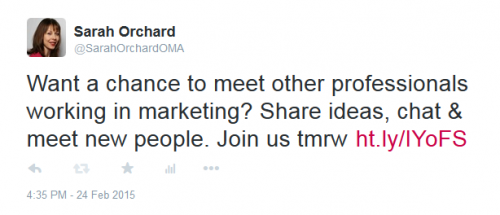 Since it was launched in 2006, Twitter has grown exponentially in size and use. By the end of 2014 it was firmly established in the top 10 of websites visited, had over 500 million users and well in excess of 280 million active users. Who knows what those figures might look like by the end of 2015!
Since it was launched in 2006, Twitter has grown exponentially in size and use. By the end of 2014 it was firmly established in the top 10 of websites visited, had over 500 million users and well in excess of 280 million active users. Who knows what those figures might look like by the end of 2015!
Of course, alongside such phenomenal use of the service there is plenty of useless messages flying around – and the constraints of 140 characters can sometimes be seen as a blessing! But with all this ‘noise’ – whether it’s from Z-list celebrities or the common man – businesses have to think about how they are using Twitter and if they are using it to the best effect.
So, have you ever seriously asked yourself why you tweet?
Have you set out to use Twitter with a specific purpose? Or are you simply dabbling because ‘everyone and even his dog’ has a Twitter account these days?!
When it comes to Twitter, my advice to any small business is to be single minded and focused. For instance, your website is probably one of your primary sales and marketing tools. The more traffic you can drive to your website, the greater the chance that you will gain new clients or increase sales. Used well, Twitter can push your audience to take a desired course of action. This is known as a Direct Response Tweet and could cover any of the following examples:
- visit your website to discover your services or products
- view a specific product page and make a purchase
- capture their email address via a competition, gated download/resource or by claiming a limited time special offer
- gain followers and generate retweets
- get them to sign up to your email updates in advance of your next great campaign going out!
- cross-promote platforms – make Twitter users aware of your other social media platforms, such as Like our Facebook page and so on.
So how do you do it?
Once you get into the swing of things, creating an effective direct response tweet won’t feel difficult (remember, it’s only 140 characters after all!).
My quick step-by-step guide:
1. Ask a direct question that relates to the needs of your target audience.
2. Offer a relevant solution that grabs interest and creates curiosity.
3. Include a clear call to action. Tell them what they need to do next.
4. Add the link that will get them to where you intend them to be, whether it’s a particular page on your website or your Facebook business page.
Here is how the tweet might look:
 Avoid adding hashtags because they offer a distraction from the main message. And don’t go mad with exclamation marks, this will reduce the clicks too. But do embrace persuasive language that will help your audience connect and respond on a more emotional level. Words like exclusive, bonus, free and sale are more effective than discount, deal and promo. You can even afford to go a bit over the top – don’t just describe your product as ‘good’, make it ‘amazing’ or ‘best’. And always, always, always remember the rule of ‘don’t ‘we’ all over ‘you’’ – speak to your audience, get that all-important ‘you’ into your tweet, forget about ‘we’ the company.
Avoid adding hashtags because they offer a distraction from the main message. And don’t go mad with exclamation marks, this will reduce the clicks too. But do embrace persuasive language that will help your audience connect and respond on a more emotional level. Words like exclusive, bonus, free and sale are more effective than discount, deal and promo. You can even afford to go a bit over the top – don’t just describe your product as ‘good’, make it ‘amazing’ or ‘best’. And always, always, always remember the rule of ‘don’t ‘we’ all over ‘you’’ – speak to your audience, get that all-important ‘you’ into your tweet, forget about ‘we’ the company.
